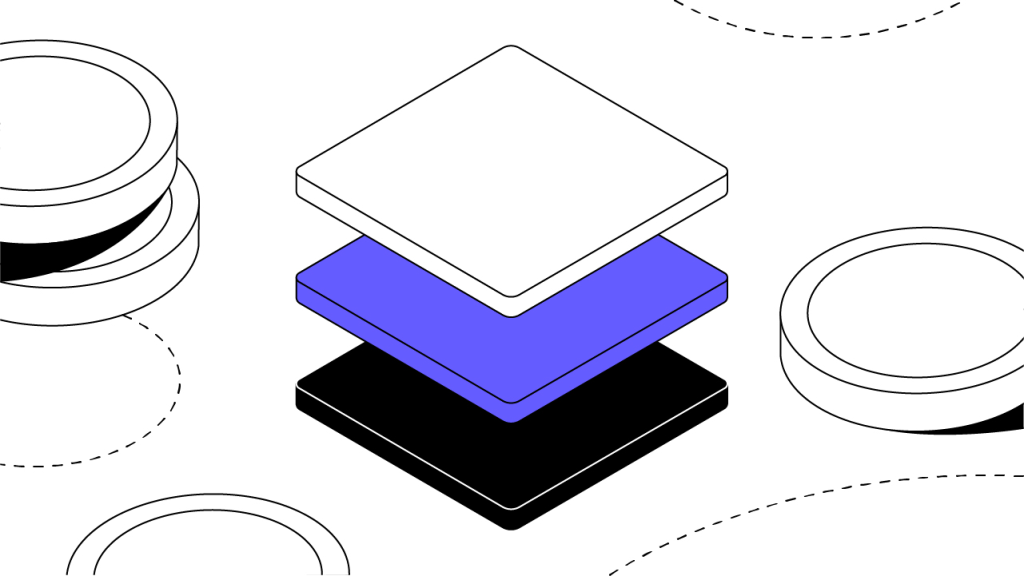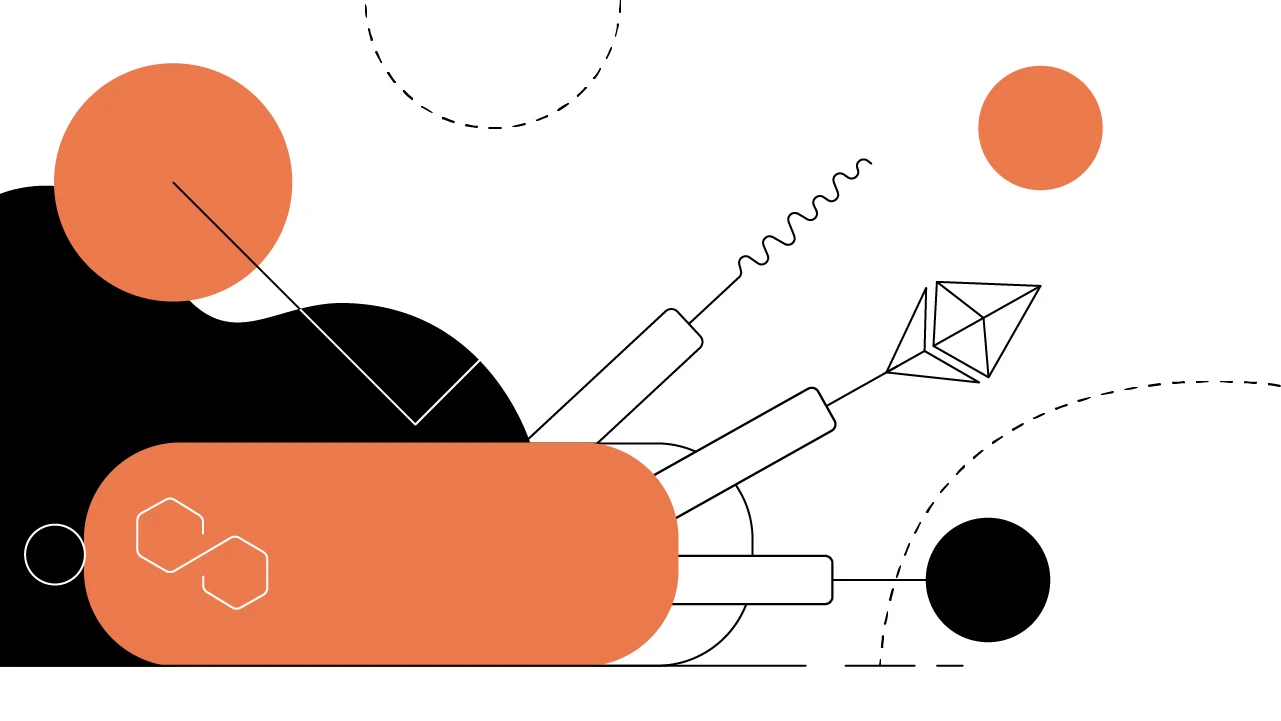Contents
Layer-1 and Layer-2 Blockchain Scaling Solutions
There are two primary ways to achieve blockchain scalability: Layer-1 and Layer-2 solutions.
Updated November 16, 2023 • 5 min read

Summary
To compete with legacy systems of payment processing, blockchain networks must become highly scalable — capable of accommodating an exponentially growing number of users, transactions, and data. Only by adequately incorporating scalability into their structure do blockchain networks stand to supersede other legacy systems. Layer-1 solutions add utility to a native blockchain to optimize its performance. Layer-2 solutions are third-party protocols that integrate with an underlying Layer-1 blockchain to increase transactional throughput.
What Is Blockchain Scalability?
While blockchain technology is proving itself to be a new pillar of the global economy, its underlying structure of decentralized networks faces a unique challenge known as the Blockchain Trilemma: the balancing act between decentralization, security, and scalability within a blockchain infrastructure.
Blockchain decentralization refers to the meaningful distribution of computing power and consensus throughout a network, while security reflects a blockchain protocol’s defenses against malicious actors and network attacks. Both are considered non-negotiable to the function of a blockchain network.
Also essential is scalability, which refers to a blockchain network’s ability to support high transactional throughput and future growth. Scalability is crucial because it represents the only way for blockchain networks to reasonably compete with legacy, centralized platforms with rapid settlement times. A commonly used comparison to indicate the gulf in scalability is that Bitcoin processes between 4–7 transactions per second (TPS). Visa, on the other hand, processes thousands of TPS. In order to compete with these existing systems, blockchain technology must match or exceed these high levels of scalability. There now exists an entire sub-sector of the blockchain industry that’s working towards improving scalability.
Thankfully, a whole new generation of blockchains and scaling solutions built specifically to solve this transaction-capacity problem is exponentially increasing the scaling limits of blockchain and making meaningful progress. These projects address scalability in two different ways: Layer-1 and Layer-2 scaling solutions.
Layer-1 Scaling Solutions
In the decentralized ecosystem, a Layer-1 network refers to a blockchain, while a Layer-2 protocol is a third-party integration that can be used in conjunction with a Layer-1 blockchain. Bitcoin, Litecoin, and Ethereum, for example, are Layer-1 blockchains. Layer-1 scaling solutions augment the base layer of the blockchain protocol itself in order to improve scalability. A number of methodologies are currently being developed — and practiced — that improve the scalability of blockchain networks directly.
Here’s how it works: Layer-1 solutions change the rules of the protocol directly to increase transaction capacity and speed, while accommodating more users and data. Layer-1 scaling solutions can entail, for example, increasing the amount of data contained in each block, or accelerating the rate at which blocks are confirmed, so as to increase overall network throughput.
Other foundational updates to a blockchain to achieve Layer-1 network scaling include:
Consensus protocol improvements: Some consensus mechanisms are more efficient than others. Proof of Work (PoW) is the consensus protocol currently in use on popular blockchain networks like Bitcoin. Although PoW is secure, it can be slow. That’s why many newer blockchain networks favor the Proof-of-Stake (PoS) consensus mechanism. Instead of requiring miners to solve cryptographic algorithms using substantial computing power, PoS systems process and validate new blocks of transaction data based on participants staking collateral in the network.
With Ethereum 2.0, Ethereum will transition to a PoS consensus algorithm, which is expected to dramatically and fundamentally increase the capacity of the Ethereum network while increasing decentralization and preserving network security.
Sharding: Sharding is a mechanism adapted from distributed databases that has become one of the most popular Layer-1 scaling solutions, despite its somewhat experimental nature within the blockchain sector. Sharding entails breaking the state of the entire blockchain network into distinct datasets called "shards" — a more manageable task than requiring all nodes to maintain the entire network. These network shards are simultaneously processed in parallel by the network, allowing for sequential work on numerous transactions.
Further, each network node is assigned to a particular shard instead of maintaining a copy of the blockchain in its entirety. Individual shards provide proofs to the mainchain and interact with one another to share addresses, balances, and general states using cross-shard communication protocols. Ethereum 2.0 is one high-profile blockchain protocol that is exploring shards, along with Zilliqa, Tezos, and Qtum.
Layer-2 Scaling Solutions
Layer-2 refers to a network or technology that operates on top of an underlying blockchain protocol to improve its scalability and efficiency. This category of scaling solutions entails shifting a portion of a blockchain protocol’s transactional burden to an adjacent system architecture, which then handles the brunt of the network’s processing and only subsequently reports back to the main blockchain to finalize its results. By abstracting the majority of data processing to auxiliary architecture, the base layer blockchain becomes less congested — and ultimately more scalable.
For instance, Bitcoin is a Layer-1 network, and the Lightning Network is a Layer-2 solution built to improve transaction speeds in this fashion on the Bitcoin network. Other examples of Layer-2 solutions include:
Nested blockchains: A nested blockchain is essentially a blockchain within — or, rather, atop — another blockchain. The nested blockchain architecture typically involves a main blockchain that sets parameters for a broader network, while executions are undertaken on an interconnected web of secondary chains. Multiple blockchain levels can be built upon a mainchain, with each level using a parent-child connection. The parent chain delegates work to child chains that process and return it to the parent after completion. The underlying base blockchain does not take part in the network functions of secondary chains unless dispute resolution is necessary.
The distribution of work under this model reduces the processing burden on the mainchain to exponentially improve scalability. The OMG Plasma project is an example of Layer-2 nested blockchain infrastructure that is utilized atop the Layer-1 Ethereum protocol to facilitate faster and cheaper transactions.
State channels: A state channel facilitates two-way communication between a blockchain and off-chain transactional channels and improves overall transaction capacity and speed. A state channel does not require validation by nodes of the Layer-1 network. Instead, it is a network-adjacent resource that is sealed off by using a multi-signature or smart contract mechanism. When a transaction or batch of transactions is completed on a state channel, the final “state” of the “channel” and all its inherent transitions are recorded to the underlying blockchain. The Liquid Network, Celer, Bitcoin Lightning, and Ethereum's Raiden Network are examples of state channels. In the Blockchain Trilemma tradeoff, state channels sacrifice some degree of decentralization to achieve greater scalability.
Sidechains: A sidechain is a blockchain-adjacent transactional chain that’s typically used for large batch transactions. Sidechains use an independent consensus mechanism — i.e., separate from the original chain — which can be optimized for speed and scalability. With a sidechain architecture, the primary role of the mainchain is to maintain overall security, confirm batched transaction records, and resolve disputes. Sidechains are differentiated from state channels in a number of integral ways. Firstly, sidechain transactions aren’t private between participants — they are publicly recorded to the ledger. Further, sidechain security breaches do not impact the mainchain or other sidechains. Establishing a sidechain might require substantial effort, as the infrastructure is usually built from the ground up.
Boosting Blockchain Network Scalability
Layer-1 and Layer-2 scaling solutions are two sides of the same crypto coin: They’re strategies designed to make blockchain networks faster and more accommodating to a rapidly growing user base. These strategies are not mutually exclusive either, and many blockchain networks are exploring combinations of Layer-1 and Layer-2 scaling solutions to achieve increased scalability without sacrificing adequate security or decentralization.
Cryptopedia does not guarantee the reliability of the Site content and shall not be held liable for any errors, omissions, or inaccuracies. The opinions and views expressed in any Cryptopedia article are solely those of the author(s) and do not reflect the opinions of Gemini or its management. The information provided on the Site is for informational purposes only, and it does not constitute an endorsement of any of the products and services discussed or investment, financial, or trading advice. A qualified professional should be consulted prior to making financial decisions. Please visit our Cryptopedia Site Policy to learn more.

Is this article helpful?


